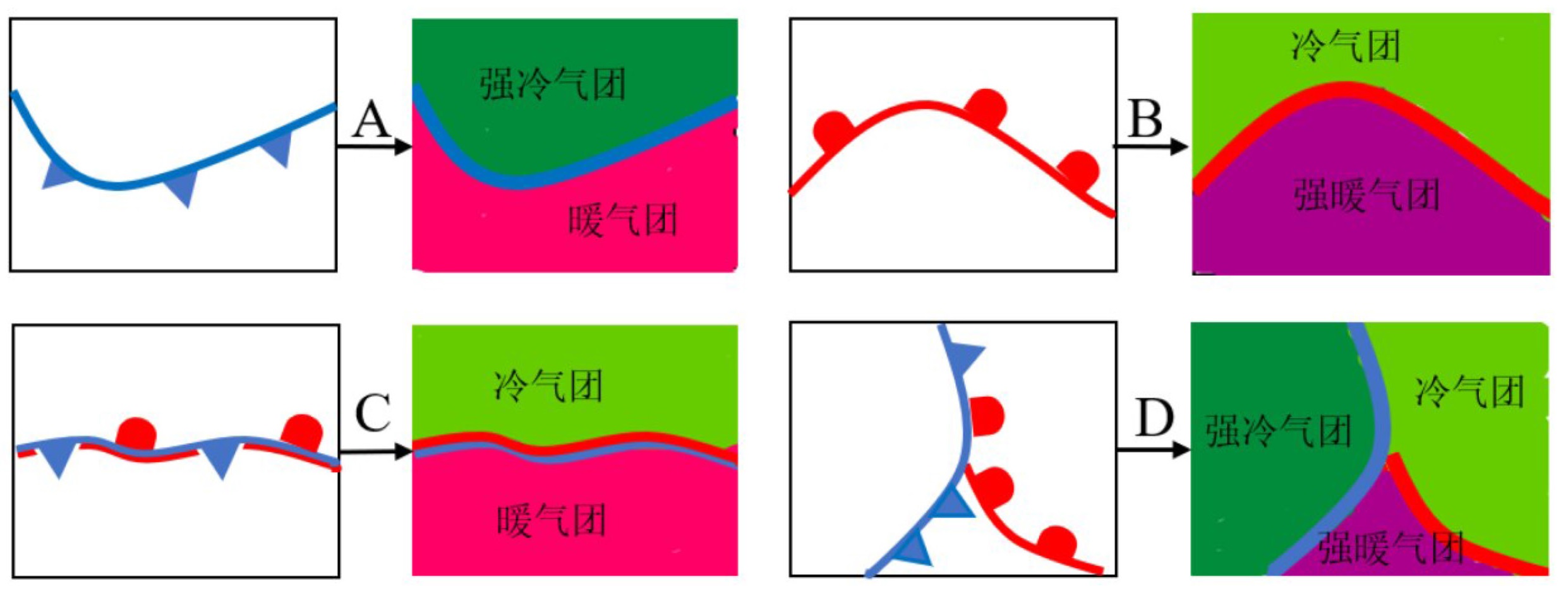Road Weather Condition Prediction Based on Numerical Weather Prediction and Machine Learning Technology
-
摘要: 目前自动识别锋面的机器学习方法,因使用的锋面标签中有锋格点与无锋格点的比例严重不平衡,易导致训练的网络识别结果偏向无锋类别的问题,另外,网络输入的多气象要素,因特殊天气情况和地理位置等原因会产生数据特征冲突或者数据信息质量差的问题,造成输入数据与网络不匹配,后果是网络训练困难,识别准确度受影响。为此,提出一种基于气团标签训练AMA-UNet(自适应融合多气象要素U型网络)模型来进行锋面智能识别的方法,该方法使用欧洲中期天气预报中心的ERA5数据集的多个气象因子作为网络输入,将美国天气预报中心(WPC)提供的锋面数据集制作成气团标签以解决锋面标签中无锋类别与有锋类别的严重不平衡,同时利用AMA-UNet架构中的适配器解决输入数据与网络的不匹配问题,利于网络训练的同时,提高网络的综合性能。实验表明,气团作为标签比锋面直接作为标签训练的网络在评估指标上平均约提升5%,增加适配器后,网络在多评估指标上平均约提升3%,与其他方法相比各评估指标均有大幅提升。Abstract: Current machine learning methods for the automatic identification of fronts often face challenges due to a serious imbalance in the proportion of frontal grid points versus non-frontal grid points in the training labels. This imbalance can lead to biased recognition results in favor of the non-frontal category. Moreover, the input of multiple meteorological elements may result in data feature conflicts or poor quality data due to special weather conditions and geographic variations, leading to mismatches between input data and the network. Consequently, this affects the training process and recognition accuracy. To address these issues, we proposed a method that trains the AMA-UNet model for the intelligent identification of fronts based on air mass labels. This approach used multiple meteorological parameters from the ERA5 dataset provided by the European Centre for Medium-Range Weather Forecasts as network inputs, while generating air mass labels from the front dataset provided by the Weather Prediction Center in the U. S. This effectively mitigated the imbalance between non-frontal and frontal categories. Furthermore, the adapter in the AMA-UNet architecture was utilized to resolve the mismatch between the input data and the network, which facilitated network training and improved the comprehensive performance of the network. Experiments show that the use of air masses as labels improved evaluation metrics by approximately 5% compared to networks trained directly using fronts as labels. Moreover, incorporating adapters yielded an average improvement of about 3% across multiple evaluation metrics. This method demonstrates significant enhancements in all evaluation indexes compared with other methods.
-
Key words:
- automatic identification of fronts /
- machine learning methods /
- air mass labels /
- adapter /
- AMA-UNet
-
表 1 将ERA5数据集和气团标签按时间范围分为三类数据集
类别 时间范围(世界时) 锋面数量 训练集 2010年1月1日00时—2011年12月28日21时 96 014 2015年1月1日00时—2018年12月28日21时 242 584 2012年1月1日00时—2013年12月28日21时 112 523 验证集 迭代过程中从训练集中随机抽取 20% -- 测试集 2014年1月1日00时—12月28日21时 49 843 表 2 网络的输入和输出
输出 网络输入 最小值 最大值 代表类别 0 温度(T)/℃ -40 50 无锋面 1 2 m露点温度(Td)/℃ -20 30 冷锋 2 U风(U)/(km·h-1) 0 150 暖锋 3 V风(V)/(km·h-1) 0 150 准静止锋 4 比湿度(q)/% 15 97 锢囚锋 -- 平均海平面压力(Pmsl)/hPa 500 1 036 -- 表 3 多方法实验评估结果
方法 ACC P R F1 CNN 63.8% 64.2% 67.4% 65.7% FCN 70.8% 73.7% 76.6% 75.1% UNet 75.6% 78.5% 81.3% 79.9% AMA-UNet 81.6% 84.7% 86.5% 85.6% -
[1] 寿绍文. 天气学分析[M]. 北京: 气象出版社, 2002: 23. [2] GARNER J. A study of synoptic-scale tornado regimes. Electron[J]. J Severe torms Meteor, 2013, 8(3): 1-25. [3] CATTO J L, PFAHL S. The importance of fronts for extreme precipitation[J]. J Geophys Res Atmos, 2013, 118(19): 10 791-10 801. [4] DOWDY A, CATTO J. Extreme weather caused by concurrent cyclone, front and thunderstorm occurrences[J]. Sci Rep, 7(1): 40359. [5] CATTO N N, JAKOB C, SHELTON K L. Atmosphericfronts in present and future climates[J]. Geophys Res Lett, 2014, 41(21): 7 642-7 650. [6] CATTO, JAKOB C, NICHOLLS N. Can the CMIP5 models represent winter frontal precipitation?[J]. Geophys Res Lett, 2015, 42(20): 8 596-8 604. [7] DINES J. Life cycle of cyclones and the polar front theory of atmospheric circulation[J]. Quart J Roy Meteor Soc, 1923, 49(206): 140-141. [8] SHAPIRO M A, KEYSER D. Fronts, jet streams and the tropopause, Extratropical Cyclones, The Erik Palmén Memorial Volume[M]//Newton C W, Holopainen E O, Eds, Amer Meteor Soc, 1990: 167-191. [9] HEWSON T D. Objective fronts[J]. Meteor Appl, 1998, DOI: 10.1017/S1350482798000553. [10] MILLS G A. A re-examination of the synoptic and mesoscale meteorology of Ash Wednesday 1983 Aust[J]. Meteor Mag, 2005, 54(1): 35-55. [11] CATTO, JAKOB C, BERRY G, et al. Relating global precipitation to atmospheric fronts[J]. Geophys Res Lett, 2012, 39(10): L10805. [12] CATTO J L, PFAHL S. The importance of fronts for extreme precipitation[J]. J Geophys Res Atmos, 2013, 118(19): 10 791-10 801. [13] HOPE P, COAUTHORS. A comparison of automated methods of front recognition for climate studies: A case study in southwest Western Australia[J]. Mon Wea Rev, 2014, 142(1): 343-363. [14] NAUD C M, POSSELT D J, VAN DEN HEEVER S C. A CloudSat-CALIPSO view of cloud and precipitation properties across cold fronts over the global oceans[J]. J Climate, 2015, 28(17): 6 743-6 762. [15] RENARD R J, CLARKE L C. Experiments in numerical objective frontal analysis[J]. Mon Wea Rev, 1965, 93(9): 547-556. [16] HUBER-POCK F, KRESS C. An operational model of objective frontal analysis based on ECMWF products[J]. Meteor Atmos Phys, 1989, 41(4): 170-180. [17] MCCANN D W, WHISTLER J P. Problems and solutions for drawing fronts objectively[J]. Meteor Appl, 2001, 8(2): 195-203. [18] SIMMONDS I, LI M. Trends and variability in polar sea ice, global atmospheric circulations, and baroclinicity Ann N Y[J]. Acad Sci, 2021, 15(4): 167-186. [19] CATTO E M, JOOS H, RUDEVA I, et al. Global relationship between fronts and warm conveyor belts and the impact on extreme precipitation[J]. J Climate, 2015, 28(21): 8 411-8 429. [20] PARFITT A C, SEO H. A simple diagnostic for the detection of atmospheric fronts[J]. Geophys Res Lett, 2017, 44(9): 4 351-4 358. [21] LAGERQUIST R, ALLEN J T, MCGOVERN A. Climatology and variability of warm and cold fronts over North America from 1979 to 2018[J]. J Climate, 2020, 33(15): 6 531-6 554. [22] RUDEVA I, SIMMONDS I. Variability and trends of global atmospheric frontal activity and links with large-scale modes of variability[J]. J Climate, 2015, 28(8): 3 311-3 330. [23] HE´NIN R, RAMOS A M, SCHEMM S, et al. Assigning precipitation to midlatitudes fronts on sub-daily scales in the North Atlantic and European sector: Climatology and trends[J]. Int J Climatol, 2019, 39(1): 317-330. [24] PEPLER A S, COAUTHORS. The contributions of fronts, lows and thunderstorms to southern Australian rainfall[J]. Climate Dyn, 2020, 55 (5): 1 489-1 505. [25] SIMMONDS I, KEAY K, BYE J. Identification and climatology of Southern Hemisphere mobile fronts in a modern reanalysis[J]. J Climate, 2012, 25(6): 1 945-1 962. [26] SCHEMM S, RUDEVA I, SIMMONDS I. Extratropical fronts in the lower troposphere—Global perspectives obtained from two automated methods[J]. Quart J Roy Meteor Soc, 2015, 141(690): 1 686-1 698. [27] PARFITT R., CZAJAA, SEO H. A simple diagnostic for the detection of atmospheric fronts[J]. Geophys Res Lett, 2017, 44(19): 4 351-4 358. [28] THOMAS C M, SCHULTZ D M. What are the Best Thermodynamic Quantity and Function to Define a Front in Gridded Model Output? [J]. Bulletin of the American Meteorological Society, 2018, 100(5): 873-895. [29] FUKUSHIMA, NEOCOGNITRON K. A self-organizing neural network model for a mechanism of pattern recognition unaffected by shift in position[J]. Biol Cybern, 1980, 36(4): 193-202. [30] FUKUSHIMA, MIYAKE S. Neocognitron: A new algorithm for pattern recognition tolerant of deformations and shifts in position[J]. Pattern Recognit, 1982, 15(6): 455-469. [31] MCGOVERN A, LAGERQUIST R, GAGNE D J, et al. Making the black box more transparent: Understanding the physical implications of machine learning[J]. Bulletin of the American Meteorological Society, 2019, 100(11): 2 175-2 199. [32] LAGERQUIST R, ALLEN J T, MCGOVERN A. Climatology and Variability of Warm and Cold Fronts over North America from 1979 to 2018[J]. J Climate, 2020, 33(15): 6 531-6 554. [33] BIARD J C, KUNKEL K E. Automated detection of weather fronts using a deep learning neural network[J]. Advances in Statistical Climatology, Meteorology and Oceanography, 2019, 5(2): 147-160. [34] LONG J, SHELHAMER E, DARRELL T. Fully convolutional networks for semantic segmentation[J]. IEEE Transactions on Pattern Analysis and Machine Intelligence, 2017, Vol. 39(4): 640-651. [35] STEFAN N, MILTENBERGER A, SCHMIDT B, et al. Automated detection and classification of synoptic-scale fronts from atmospheric data grids[J]. Weather and Climate Dynamics, 2022, 3(1): 113-137. [36] OLAF R, PHILIPP F, THOMAS B. U-Net: convolutional networks for biomedical image segmentation[C]//International Conference on Medical Image Computing and Computer-Assisted Intervention. 2015 [37] KLANAR G, ZDEAR A, KRISHNAN M. Robot navigation based on potential field and gradient obtained by bilinear interpolation and a grid-based search[J]. Sensors, 2022, 22(9): 3 295. [38] TANG Y X, BAI W T, LI G L, et al. CROLoss: Towards a customizable loss for retrieval models in recommender systems[C]//CIKM '22: Proceedings of the 31st ACM International Conference on Information & Knowledge Management. 2022. -






 下载:
下载:








 粤公网安备 4401069904700003号
粤公网安备 4401069904700003号